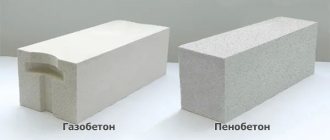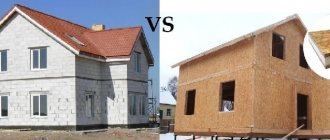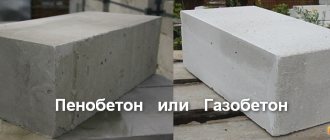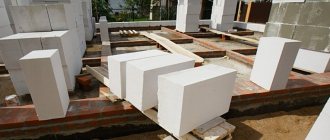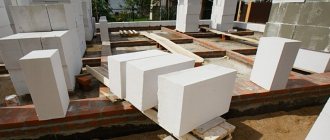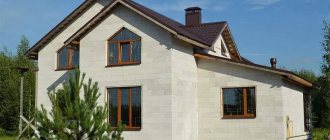The lack of natural gas in many suburbs and cottage villages has a particularly acute effect during the heating season, when you have to pay literally exorbitant prices for every kilowatt of thermal energy. But owning your own home also has its benefits. One of them is that a low-rise building can be made as warm as desired by using structural and thermal insulation materials – cellular concrete blocks – when constructing walls. They are made from foam concrete and aerated concrete, but let’s try to figure out what is the difference between them and which is better.
Blocks made of aerated concrete and foam concrete Source adscore.ru
Classification
These two types of lightweight concrete only have the same classification. The difference between foam concrete and aerated concrete lies in the density and type of material, although in regulatory documents the thermal conductivity of foam concrete and aerated concrete at the same density is considered equal.
Thus, the lightest foam concrete blocks with a density of up to 500 kg/m³ are classified as thermal insulation. And for aerated concrete, blocks with a density of up to 400 kg/m³ are considered thermal insulating.
Aerated concrete blocks with a density of 500-900 kg/m³ are considered structural and thermal insulation and serve as building materials for self-supporting walls without reinforcement. And when laying armored belts in every fourth row, they can be used to build load-bearing walls of low-rise buildings. For foam concrete, these include blocks with a density of 600-1000 kg/m³.
Foam concrete and aerated concrete blocks with a density above 1000/1100 kg/m³ are classified as structural.
For reference! Due to the optimal strength/thermal insulation ratio, the most popular blocks are D500 and D600 (the number indicates density).
A clear difference between blocks of different densities, using aerated concrete as an example Source acost.ru
But density and thermal conductivity are the only indicators that closely coincide for these two similar, but still different materials. And the differences between them lie at the level of composition and production technology. Therefore, to choose aerated concrete or foam concrete, which is better, you need to carefully study all the properties of both materials and the conditions of their use.
What is the difference?
Despite some similarities, the materials have a number of differences, due to which their areas of application in construction are significantly expanding. It is more appropriate to compare these types of building models in a tabular version.
| Criterion | Foam concrete | Aerated concrete |
| Color | Grey | White |
| Density | Low | Average |
| Thermal insulation | High | Average |
| Soundproofing | Average | good |
| Frost resistance | Average | High |
| Load limit | Low (not used for foundations) | Low (not used for foundations) |
| Flammability | Low | Low |
| Hygroscopicity | Average | High |
| Air conductivity | Average | High |
| Environmental friendliness | Average | Average |
| Price | Cheaper | Expensive |
| Application | Objects with low load | Objects with low load |
The difference is also demonstrated by the degree of shrinkage of the materials. For foam concrete modules it is 1-3 mm/m, while for aerated concrete this figure does not exceed 0.5 mm/m. Therefore, cracks in walls made of foam concrete are much more common than the same defects in aerated concrete structures.
Production technology
If we consider the structure of both types of cellular concrete, we can see that even here there are differences between them. With the same density, foam concrete visually has a greater spread of cell sizes from the smallest to the largest, and aerated concrete is more uniform. This difference in structure is determined by the way the cells are formed, but this is not the only difference between aerated concrete and foam concrete.
Foam concrete production
The composition of foam concrete is classic concrete with Portland cement binder and sand filler. Moreover, filler is added only for medium and high density foam concrete, starting with grade D500. The cellular structure is obtained by mixing the prepared concrete mixture with a foaming agent or ready-made foam. This is what distinguishes the two main manufacturing methods: classical and barotechnology.
Kit for the production of foam concrete using barotechnology Source chrome-effect.ru
Pressure technology involves adding a foaming agent directly to the mixture without using a foam generator. Usually these are mobile installations that allow you to produce foam concrete directly on site. Their productivity is low, but quite sufficient to provide building materials for the construction of a low-rise building. The disadvantage of the technology is the increased consumption of foaming agent and slightly lower strength of foam concrete compared to classical technology.
The classic technology is a little more complicated - the same prepared concrete mixture is used, but it is mixed with ready-made foam, which is obtained in a foam generator from a foam concentrate and water. The production process looks like this:
- sand is poured into the concrete mixer first (to “bind” the remaining water from the previous portion);
- add cement and water, mix until smooth;
- a portion of foam is prepared separately in a foam generator (in accordance with the required density of foam concrete);
- add foam to the concrete mixer and mix for 3-5 minutes;
- liquid foam concrete is transported through a flexible hose into a mold or formwork.
Classic scheme for the production of foam concrete Source nuxiqel.ketadilo.ru.net
See also: Catalog of house projects made from aerated concrete and foam concrete blocks
The general advantages of foam concrete production include:
- simple production technology;
- inexpensive equipment, including “mobile” equipment, which can be installed on site;
- possibility of laying in formwork for monolithic construction of walls;
- variety of ways to make blocks.
Three types of equipment are used to make building blocks from foam concrete:
- pouring into special molds, followed by stripping;
- pouring into cassette molds;
- pouring into a massive mold, followed by cutting into blocks.
Stripping, removal from cassettes and cutting occurs after the initial hardening of the mixture. When modifiers and fiber are added, this period is reduced to several hours. But the manufacturing process does not stop there - the foam blocks still have to “ripen”. It is untimely demoulding and incomplete ripening that can affect the final quality of foam concrete blocks. For example, insufficient exposure after manufacturing and before installation can lead to shrinkage of the blocks as part of the wall, and the use of waste to lubricate the molds can lead to peeling of the front part.
Stripping foam concrete blocks Source nofollow.ru
Production of aerated concrete
In composition and technology, aerated concrete is closer to silicate brick, which is why building blocks made from it are often called “gas silicate”.
A lime-cement mixture is used as a binder, which consists of ¾ of quicklime, crushed to a powder.
The classic filler is quartz sand.
To obtain a cellular structure, a gas-forming agent is used – aluminum paste or powder, consisting of 90% “active” metal.
And, as with any concrete, to “mix” clean (drinking) water is added to the mixture.
The technological process for manufacturing aerated concrete blocks looks like this:
- The sand is washed, water is added and ground to a sludge state so that the particle sizes are comparable to cement and ground lime binder.
- Sand sludge is mixed with binder.
- The gas-forming agent is diluted in water and added to the mixture of sand and binder.
- Mix all the ingredients and pour into the mold.
- After initial maturation is completed, the monolithic gas silicate is removed from the mold and cut into blocks.
Cutting aerated concrete blocks from a monolith Source chrome-effect.ru
- The blocks are placed in an autoclave, where, under the influence of saturated steam, the process of gas formation is completed, active aluminum is bound to the silicate mixture, and the cement stone is hydrophobized.
The output is fully “ripened” aerated concrete blocks, ready for packaging and transportation to the site.
For reference! The production of such blocks is possible only in industrial production conditions. In this case, it is almost impossible to “run into” handicraft products of low quality. This is the main difference between aerated concrete and foam concrete at the technology level.
What you need to know about building with cellular concrete
Both foam concrete and aerated concrete are materials that weakly resist compression and fracture, and this is their most “sore spot.” In both cases, it is necessary to apply a number of measures that will ensure effective operation of the masonry and protect it from cracking.
This is what the list looks like:
- The foundation must be rigid. Ideally, this is a monolithic slab or a reinforced concrete strip buried below the freezing level. If it is necessary to put the house on piles, then only on reinforced concrete or bored piles, with a monolithic grillage. A proper foundation is the key to successful construction using low-density masonry materials. In particular, we should not forget about the shut-off waterproofing between the plinth and the wall, which will prevent capillary rise of moisture.
- Reinforcement of areas most subject to loads. In addition to the first row of masonry, this is the lower border of the window opening, the support heels of lintels and beams, the corners of the installation, the intersections and junctions of the walls. When using autoclaved aerated concrete, horizontal reinforcement of the walls should be done every 100 cm. With a block height of 200 mm, this will be every fifth row, with a height of 250 mm - every fourth. The same applies to foam block masonry. The only thing is that they come in a height of 300 mm, so reinforcement will have to be done in every third row.
Expert opinion Vitaly Kudryashov builder, aspiring authorAsk a Question
Note: Rod reinforcement is traditionally used for this purpose, but recently fiberglass mesh has become very popular, which is best suited for strengthening thin-seam masonry.
- The higher the design loads on the walls, the higher the block density grade should be. Considering that the strength class of foam blocks is an order of magnitude lower, it is better not to load such walls with heavy floors at all. When using autoclaved aerated concrete, a block density of 600-700 kg/m³ will provide normal load-bearing capacity for monolithic or slab floors and curtain facades. Such blocks are perfect for construction in seismically vulnerable areas, since the strength class of the best brands is B5, or even B7. Foam blocks cannot boast of such characteristics, so in such construction conditions their masonry will have to be reinforced not only horizontally, but also vertically.
- And again a reminder of the need to use quality material. First, it must reach full strength. For non-autoclaved concrete this is 28 days, so look at the production date in the passport. And to be on the safe side (in case you were provided with a document that does not correspond to the batch), let the blocks rest for a couple of weeks at the site. Poorly manufactured blocks may already have a network of hairline wrinkles at the exit from the workshop, which is due to violations of the technological process. It is at least stupid to expect high-quality masonry from such material, so look immediately at what you take.
- The smaller the deviations in the nominal dimensions of the products, the easier it will be to align the planes of two adjacent blocks in the masonry. But changes should not be allowed, as they create stresses, which result in cracks.
- The cause of cracks may also be moisture accumulation, caused by improper selection of insulation or finishing facade material. It must have a higher vapor permeability than masonry, or be installed with a ventilation gap. Foam concrete does not have such a high initial humidity; it is easier in this regard.
Expert opinion Vitaly Kudryashov builder, aspiring author
Ask a Question
Important: Autoclaved aerated concrete must dry thoroughly before finishing, and the denser the material that is installed on top of it, the less moisture should remain in the masonry. If you do not pay attention to this, then in the absence or insufficient thickness of the insulation, vapors will condense, the moisture may freeze, and when thawing, contribute to the formation of cracks.
Advantages/disadvantages of foam concrete and aerated concrete
The general advantages of these two types of cellular concrete look like this:
- The availability and low cost of ingredients determines the relatively low price of building blocks. But with the same density, aerated concrete is 20-30% more expensive than foam concrete (in terms of 1 m³). This is due to high overhead costs - more expensive equipment and higher energy costs for production. And when choosing, you should pay attention that many sellers get confused in the subtleties of defining technologies - quite often aerated concrete blocks are positioned as autoclaved foam concrete.
Autoclave hardening is an industrial technology, and foam concrete is most often produced in mini-enterprises Source lestorg32.ru
- High thermal insulation properties. Each manufacturer indicates its own indicators, which may vary slightly. But foam concrete is more “stable” compared to aerated concrete and its thermal conductivity is not so dependent on the level of humidity in the surrounding air. This is explained by the closed cell structure, lower hygroscopicity and vapor permeability.
- Both materials are lightweight cellular concrete, so the load on the foundation is low.
- Both materials are non-flammable and environmentally friendly.
Having considered what properties foam concrete and aerated concrete have, what is the difference between them, can be interpreted in two ways - each feature has both a positive and a negative side.
The open cell structure of aerated concrete determines high breathability - this indicator is better than that of wood across the grain. But this same ability determines the hygroscopicity of gas silicate blocks - they easily absorb moisture, which leads to moisture in the structure and partial loss of load-bearing and thermal insulation qualities. Therefore, during breaks in construction, walls and partitions must be covered, and after construction is completed, the finishing of the facade must ensure the weathering of excess moisture.
Preservation of a block house for the winter Source proektproekt.com
In foam concrete, most cells have a closed shell. Only in blocks that are cut into solids, the top layer is characterized by an open structure. Therefore, the vapor permeability of foam concrete is almost as low as that of ordinary concrete. This means that the blocks do not have breathable properties, but their water absorption is low. And in this case, the external decoration is more of a decorative rather than protective nature.
In terms of compressive strength, aerated concrete blocks are slightly better than foam concrete blocks. So, with the same density D500, foam concrete from most manufacturers is classified as thermal insulation with strength class B1, and aerated concrete is classified as structural and thermal insulation with class B2.5.
The dimensional accuracy of building blocks is largely influenced by production culture. Gas silicate blocks, obtained by cutting from solid wood, have an absolute match in size and a perfectly flat surface. This allows them to be laid on an adhesive mixture with a minimum joint thickness, which almost completely eliminates heat loss that occurs with conventional masonry techniques. Even better in this regard are walls made of tongue-and-groove aerated concrete blocks, which do not have “through” vertical joints.
Tongue-and-groove form of gas block Source td-germes.ru
Foam concrete blocks produced by casting into molds do not have such precise geometry. And only blocks cut from solid wood are distinguished by their dimensional stability in one batch. In this question, which is better, aerated concrete or foam concrete, the second loses significantly.
Subtleties of block selection
Before choosing a structural material, each developer asks questions regarding economic benefits, optimal price-quality ratio, performance characteristics of walls and their service life. Finding reliable information can be difficult, and yet many difficulties can arise during construction.
- We will not discover America if we repeat for the hundredth time that the quality of the purchased blocks is decisive. This mainly concerns foam concrete, because it is this inherently excellent material that is most often manufactured incorrectly and does not have the characteristics that the standard prescribes for it.
- Therefore, do not buy products without a passport! This document is drawn up by the manufacturer for each batch of blocks. From it you can find out not only under what conditions the concrete was hardened, but also in what way the products were formed: by casting into separate molds or by cutting a monolith. In the second case, the accuracy of the geometric dimensions of the products is higher, and therefore they are more expensive.
Expert opinion Vitaly Kudryashov builder, aspiring authorAsk a Question
By the way: Aerated concrete, even hydration hardening, is not made by injection molding at all, so the accuracy of parameters for such blocks is always higher.
- In pursuit of cheapness, many developers pay attention to injection molded non-autoclave products. If the most priority criterion for a person is price, then it is useless to compare foam concrete or aerated concrete, discuss the advantages and disadvantages, or make comparisons.
- Meanwhile, you can buy a natural pig in a poke: you unpack the pallet and find that the products are crooked, with chips and hairline cracks. You can return it if you find someone. However, this is also an extra expense: delivery, loading and unloading - again, nerves.
At the low price of the blocks, your savings will end, because due to the curvature of the edges, the masonry joint thickens - and this means extra costs for mortar or glue. It is beneficial to use glue only for thin-seam masonry. When the seam thickness is more than 3-5 mm, it is cheaper to use DSP, but since its thermal conductivity coefficient is higher than that of foam concrete, the masonry will lose heat intensively. And these are also expenses for insulation and heating.
Foam block or gas block: what to choose.
The key question that arises when choosing between these two materials is which one is better suited for individual construction. There is no single answer to this question.
Foam concrete will cost less, since the cost of its production is relatively low. Despite this, taking into account the subsequent costs of processing and additional reinforcement, the total price tag may be much higher.
The gas block differs from the foam block in its geometric correctness, which gives it many advantages. This material will be conveniently placed on a special glue, which is used in minimal quantities. At the same time, the surface of foam concrete has unevenness, and because of this it must be placed on cement mortar, which is used in significant quantities.
Aerated concrete does not require processing and leveling, unlike foam concrete. Thus, it is clear that even an initially cheap material gives a much higher cost estimate than one that is more expensive.
It is also important to consider the construction process itself. Laying building material on glue is much more difficult work; laying on cement takes weeks. Considering the differences between gas blocks and foam blocks, we can draw a conclusion. People who do not yet have experience in individual construction should start with foam concrete, but choose only the highest quality option. Those who can already call themselves an experienced builder can safely work with aerated concrete.
Calculation of the number of foam blocks
| Selection of block size, LxHxD | |
| Total length of walls, meters | |
| Average height of walls, meters | |
| Total area of window and door openings, m2 | |
| Number of blocks: | m3 | PC. |
| Number of blocks multiple to pallet: | m3 | PC. |
| Number of blocks per pallet: | ||
| Number of pallets: | ||
Strength
When choosing a foam block or aerated block, it is important to consider the strength of the material. This characteristic directly depends on porosity. The more porous the product, the lower the density and reliability, respectively. The most durable compositions are used in the construction of load-bearing structures, the least - in providing thermal insulation.
Foam block is a fairly durable material. And although its density is lower than that of brick or concrete, it also has good performance. Moreover, certain models of foam blocks can be used with additional reinforcement.
Due to its hygroscopicity, gas block is not the most durable material. It absorbs water very quickly, as it has open pores, and this is considered one of its main disadvantages. If aerated concrete is used in the construction of a house, then it is necessary to subsequently ensure effective waterproofing.
Moisture resistance
In terms of moisture resistance, foam concrete blocks or aerated concrete blocks have similar characteristics. Both of these materials are not moisture resistant.
Reduced water absorption is a property of foam blocks, which allows you to increase the service life of buildings. Due to the closed pores, foam concrete blocks, absorbing a small amount of water, are able to float better.
The moisture resistance of aerated concrete blocks is quite high. This is achieved even with a porous material structure. Due to the use of creation technology, aerated concrete remains dry, and moisture is released into the environment. Aerated blocks have greater moisture resistance than most other building materials.
Weight
The mass of each individual foam block can be found by multiplying its volume by the density specified by the manufacturer. A block of standard dimensions 600x300x200 mm has a volume of 0.036 m3, so with a foam concrete density of 650 kg/m3, it will weigh 23.4 kg. A more durable version of the same parameters will weigh around 40 kg, the lightest – 10 kg.
Aerated block is also a fairly lightweight material, its weight is three times less than a brick of the same parameters. Most often you can find the following sizes: 600x200x300 mm, 600x250x250. On average, the weight of a 600×300×200 gas block is 20 – 23 kg.
Characteristics of gas blocks
The porosity of aerated concrete blocks occurs when a gas-forming agent - aluminum powder - reacts with lime under the influence of high temperature and pressure in an autoclave oven.
During the reaction, gas appears, which, when released, forms a network of microcracks and bubbles in the body of the block. The resulting cells are open in nature and allow air to pass freely, which has a positive effect on the vapor permeability of the material.
Composition of aerated concrete
- Portland cement grade not lower than M400;
- Fine sand;
- Lime;
- Water;
- Aluminum powder or paste;
- Chemical additives and plasticizers (if necessary).
Advantages of aerated concrete blocks
The advantages of aerated concrete include the following properties:
- Durability – manufacturing takes place using an autoclave method, which guarantees high levels of strength and longevity;
- Lightness - the presence of voids in the structure of the block makes it noticeably lighter in comparison with conventional concrete;
- Ease of processing - aerated concrete does not require special tools for additional processing - cutting, drilling, sawing, etc.;
- Low thermal conductivity - gas blocks retain heat well, the room quickly warms up and cools down slowly;
- Fire resistance – blocks can withstand up to 8 hours of exposure to fire, maintaining technical characteristics;
- Sound insulation – voids in the body of the block absorb noise;
- Biostability – aerated concrete is not susceptible to damage from fungus, mold, insects and rodents;
Cons of aerated concrete
Among the negative properties is poor resistance to moisture. Gas, during the manufacture of blocks, formed a network of microcracks in the structure of the block, which absorb and conduct water. Therefore, during construction it is necessary to carefully consider the waterproofing of the structure.
Developers also note low bending strength and difficulty in attaching additional elements. To hang a shelf or cabinet on a wall made of aerated blocks, you need to use special fasteners.
